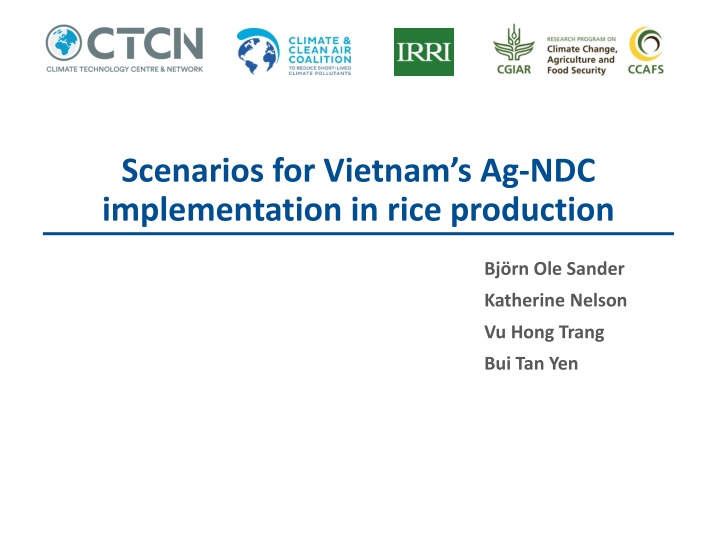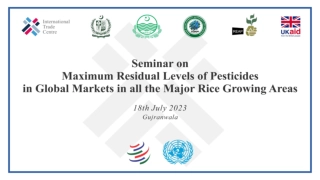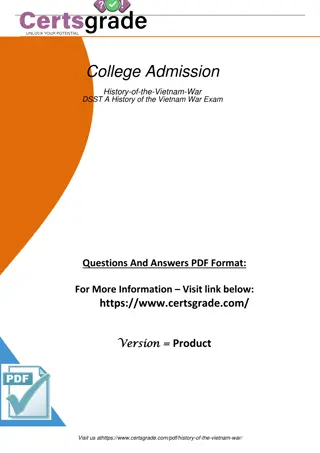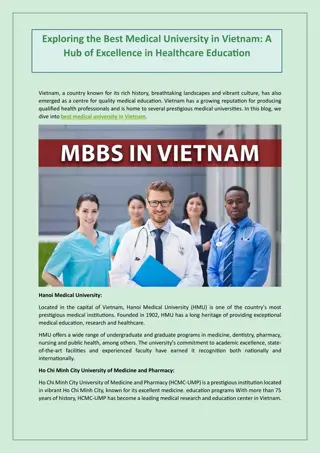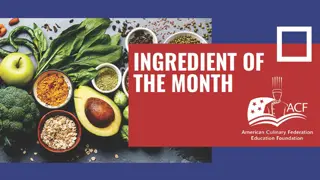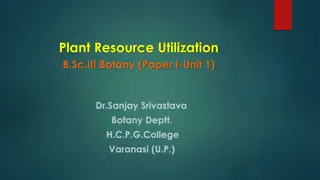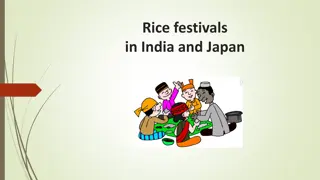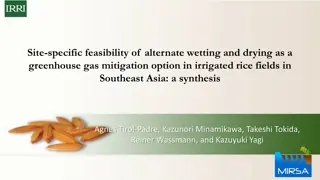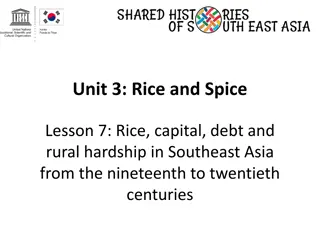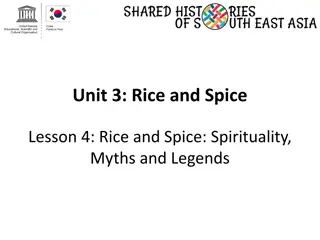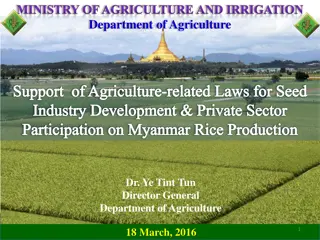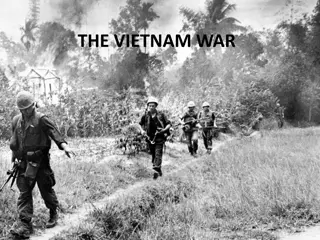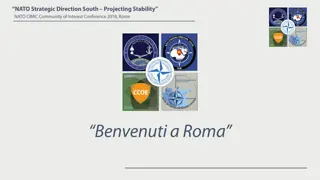Scenarios for Vietnam's Ag-NDC Implementation in Rice Production
A comprehensive analysis of Vietnam's NDC targets in the rice sector, focusing on GHG emissions, suitability for water-saving technologies, implementation scenarios, investment costs, and challenges. The plan aims to reduce GHG through effective water management strategies in rice cultivation. Explore the outlined strategies, emission factors, baseline choices, and the contribution of agriculture towards achieving the NDC targets by 2030.
Download Presentation

Please find below an Image/Link to download the presentation.
The content on the website is provided AS IS for your information and personal use only. It may not be sold, licensed, or shared on other websites without obtaining consent from the author.If you encounter any issues during the download, it is possible that the publisher has removed the file from their server.
You are allowed to download the files provided on this website for personal or commercial use, subject to the condition that they are used lawfully. All files are the property of their respective owners.
The content on the website is provided AS IS for your information and personal use only. It may not be sold, licensed, or shared on other websites without obtaining consent from the author.
E N D
Presentation Transcript
Scenarios for Vietnams Ag-NDC implementation in rice production Bj rn Ole Sander Katherine Nelson Vu Hong Trang Bui Tan Yen
Outline 1. GHG emission from rice cultivation and NDC targets 2. Suitability assessment for water-saving technologies in rice production 3. Scenarios for NDC implementation 4. Investment costs and benefits 5. Issues: Choice of Emission Factors and Baseline 6. Conclusions and Challenges
Vietnams NDC target in rice sector GHG emission from rice cultivation - Rice seasons: Jan-Apr Harvest (JAH), May-Aug Harvest (MAH) and September-December Harvest (SDH) - Total Planted area: 7.47 mill ha - Total estimated GHG emission: 44.7 Mt CO2e (50% of total agriculture emissions) Vietnam s NDC targets up to 2030 - 2016 submission : reduction of 8% and 25% of BAU - 2020 update : reduction of 9% and 27% of BAU Implementation plan to reduce GHG through water management in the rice sector - MONRE.2015*: 200,000 ha AWD (Domestic investment) 1,500,000 ha AWD (International support) - MARD.2016**: 200,000 ha AWD + 1mill ha MSD (Domestic) 500,000 haAWD(International) Total implementation area: 1.7 mil ha OR 23% of rice area * MoNRE, 2015. Technical report: Vietnam's Intended Nationally Determined Contribution ** MARD.2016. NDC implementation plan in Agriculture (Document 7208/BNN-KHCN)
NDC targets by 2030 Contribution of agriculture in the updated NDC (2020) 1. Domestic ( unconditional ): 6.8 MtCO2e/yr (assume 3.4MtCO2e rice) 2. With intl. support ( conditional ): 25.8 MtCO2e/yr (assume12.9MtCO2e rice) 3. Combined target: 32.6MtCO2e/yr (assume16.3MtCO2e rice) Rice Emissions Agricultural Emissions Vietnam 120 50 BAU 50 110 45 100 Domestic 45 40 Million tons paddy 90 MtCO2e International 40 MtCO2e 80 35 Both 70 35 30 60 Annual paddy production 30 25 50 40 20 25 3 1995 2000 2005 2010 2014 2020 1995 2025 2000 2030 2005 2010 2014 2020 2025 2030
Mapping suitable area for water saving practices using MapAWD tool JAH = Jan Apr harvest; MAH= May-Aug harvest; and SDH = Sep-Dec harvest Suitability analysis is mainly based on bio-physical factors. The actual implementing area will be reduced depending on local adoption capacity Suitability level/ Practice Potential area (1000 ha) JAH MAH SDH Annual 1,991.85 1,809.33 339.82 4,141.00 Highly suitable (AWD/MSD) 30.20 479.89 380.79 890.88 Moderately suitable (MSD)
Climatically suitable area for AWD in RRD Highly suitable Moderately suitable Lowly suitable Not suitable No planted Jan-Apr Harvest Sep-Dec Harvest May-Aug Harvest Climatically suitable area (ha) MAH 451,371 237,404 Suitability level/ practice High (AWD/MSD) Medium (MSD) JAH - - SDH 20,718 63,045 5
Climatically suitable area for AWD in MRD Highly suitable Moderately suitable Lowly suitable Not suitable No planted Jan-Apr Harvest Sep-Dec Harvest May-Aug Harvest Climatically suitable area (ha) MAH 556,189 172,988 Suitability level/ practice High (AWD/MSD) Medium (MSD) JAH SDH 119,641 251,577 1,620,874 6,016 6
AWD/MSD implementation scenarios following MARD (QD-7208-BNN - 2016) Proposed area for NDC implementation (ha) Funding Domestic International Scenario 1 (200,000 ha AWD) Scenario 2 (1 mil ha MSD) Scenario 3 Scenarios (500 thousand ha AWD) Season JAH MAH JAH MAH JAH MAH Red River Delta - 50,000 - 200,000 - 100,000 Mekong River Delta 150,000 - 400,000 400,000 200,000 200,000 Total area 200,000 1,000,000 500,000 MARD s annual mitigation target by 2030 (MtCO2e) 0.94 3.2 2.34 Domestic investment - Scenario 1 + 2 = 4.14 MtCO2e/yr International support - Scenario 3 = 2.34 MtCO2e/yr Both = 6.48 MtCO2e/yr 7
Estimation of GHG emission under different scenarios Comparison MARD targets and IRRI est. Comparison of Scenario 1 mitigation estimates with different straw incorporation amounts 3.5 3.2 3.0 1.49 3.0 2.4 2.34 2.5 MtCO2e 2.0 1.00 MtCO2e 1.5 IRRI_Est 1.0 0.94 MARD targets 0.58 1.0 0.5 - Scenario 1 (200,000 ha AWD) Scenario 2 (1,000,000 ha MSD) Scenario 3 (500,000 ha AWD) 0t straw 2t straw 4t straw Different amounts of straw incorporation Assumption: ~ 2 tonnes of straw being incorporated before each season in MRD. Sources: IRRI_Est: use emission factors from MoNRE, 2015. Technical report: Vietnam's Intended Nationally Determined Contribution MARD targets (2016) Document 7208/BNN-KHCN: use same emission factors from MoNRE 2015. 8
Domestic mitigation benefits Mitigation for Domestic investment from rice sector action Other rice NDC actions: 200k ha rice converted to upland i.e., Convert to maize = reduction potential of 8.5tCO2e/ha x 200,000ha= 1.7MtCO2e 8 7 200k ha to aquaculture 1.7 6 1.7MtCO2e 200k ha rice converted to aquaculture Assume similar reduction potential to maize = Remaining: 2.79 200k ha to upland 1.7 Total mitigation from rice actions: 7.41 MtCO2e 5 MtCO2e 4 Additional mitigation from other rice NDC actions: 3.4MtCO2e 3 Scenarios 1 + 2 (200k ha AWD + 1mil ha MSD): 4.01 Total estimated mitigation from rice actions with domestic investment: 7.41 MtCO2e 2 1 0 *Zhang, D., Shen, J., Zhang, F. et al. Carbon footprint of grain production in China. Sci Rep 7, 4126 (2017). https://doi.org/10.1038/s41598-017- 04182-x Annual mitigation by 2030 9
International mitigation benefits Other rice NDC actions: Additional 1Mil ha converted to AWD = 4.72 MtCO2e (poor/moderate infrastructure estimate higher costs per hectare) Mitigation for International investment from rice sector action 30 25 Additional 1 mil ha converted to Integrated crop management = 3 MtCO2e 20 Total estimated rice contribution to International support commitment: 10.08MtCO2e Still remaining after all rice actions: MtCO2e Remaining: 23.4 15.72 15 Other intl supported agriculture NDC actions need to account for 15.72 MtCO2e Improving diet for dairy cows Improving diet for beef cows Improving diet for buffaloes Reusing ag waste 10 1 Mil ha ICM: 3 Total mitigation from 1 Mil ha AWD: 4.72 rice actions: 10.08 MtCO2e 5 Integrated crop management for upland crops Replace urea fertilizer with slow-soluble nitrogen Drip irrigation combined with fertilizing coffee Reuse animal waste as organic fertilizer Scenario 3 500k ha AWD: 2.36 0 Annual mitigation by 2030 10 * MARD s official letter to line ministry on Consultation for NDC implementation in Agriculture (No.7286/BNN-KHCN)
Assumptions for scenarios Investment Domestic International Scenario / area / action Scenario 1 200k ha AWD Scenario 2 1Mil ha MSD Scenario 3 500k ha AWD Infrastructure assumptions - Good existing infrastructure - No hard infrastructure needed - Good existing infrastructure - No hard infrastructure needed - Mix of moderate and poor infrastructure - Hard infrastructure needed Costs* Training, MRV, research - planted area ($160/ha) Training, MRV, research - planted area (100% 1st season - $160, 33% in 2nd season - $53) Hard infrastructure applied to land area + training, MRV, research planted area ($802/ha + $53/ha 2nd season) Scenario implementation 10% conversion each year (100% by yr 10) 10% conversion each year (100% by yr 10) 10% conversion each year (100% by yr 10) Discount rate and timeline 10% / 10 years 10% / 10 years 10% / 10 years * Investment cost source: Tran VT et al 2019 11
Cost Results Unit Scenario 1 - 200k ha AWD Scenario 2 - 1 Mil ha MSD Scenario 1+2 - 1.2Mil ha Scenario 3 - 500k ha AWD Scenario 4 1 mil ha AWD + 1 mil ha ICM (MSD) Investment cost 149.3 251 1,005 2,577 Million USD 32.0 117.3 Annual benefit for farmers Million USD/year 12.7 18 73 8.0 4.7 Cost/ha* 124.4 503 503 2,075 USD/ha 160.0 117.3 Cost/tCO2e 6.8 19 19 95 USD/tCO2e 6.0 7.0 Mitigation/ha tCO2e 3.34 4.72 3.9 4.85 3.05 Domestic International **Cost estimates for irrigation infrastructure have a wide range up to $2075/ha ($95/tCO2e) depending on the source (ranges from 3x 14x more than scenarios where only operational costs are needed) 12 Investment cost source: Tran VT et al. 2019*, Trinh, M. Presentation, 2020.**
Issues New emission factors affect the mitigation in scenarios What is the baseline used for NDCs? BAU emissions assume 100% continuous flooding while there has already been considerable transformation to MSD and AWD since 2014 13
1. Emission factors Old EFs New EFs RRD 3.05 2.2 MRD JAH 2.15 1.7 MRD MAH 2.2 2.8 Comparison of mitigation using 'old' and 'new' emission factors Old Efs New Efs 4.15 4.01 3.31 3.05 MtCO2e 2.57 2.36 0.97 0.84 Scenario 1 Scenario 2 Scenario 1+2 Scenario 3 14 Vo et al. (2020) - https://doi.org/10.3390/cli8060074
2. Baselines: AWD suitability analysis for An Giang Jan-Apr Harvest (Winter-Spring) May-Aug Harvest (Summer-Autumn) Sep-Dec Harvest (Autumn-Winter) Not suitable (CF) Moderately suitable (MSD) Lowly suitable(CF) No planted Highly suitable (AWD/MSD) % of suitability: High (AWD/MSD) = 89.5 % Medium (MSD) = 0 % Low (CF) = 10.45 % % of suitability: High (AWD/MSD) = 67.0 % Medium (MSD) = 16.4 % Low (CF) = 16.6 % % of suitability: High (AWD/MSD) = 10.3 % Medium (MSD) = 27.6 % Low (CF) = 62.1 %
2019 adoption rate of AWD and MSD in An Giang Jan-Apr Harvest (Winter-Spring) May-Aug Harvest (Summer-Autumn) Sep-Dec Harvest (Autumn-Winter) AWD MSD CF Provincial average: AWD = 53.3 % MSD = 40.8 % CF = 5.9 % Provincial average: AWD = 36.6 % MSD = 54.3 % CF = 9.1 % Provincial average: AWD = 15.9 % MSD = 45.5 % CF = 38.6 % 16
Current and potential GHG emission in An Giang Emission scenarios in An Giang province Mitigation potential (Kt CO2e) Yearly WS SA AW A. Emission from 100% CF 8,431 2,866 2,797 2,767 B. Mitigation from current adoption 1,659 845 814 526 3,500 3,000 C. Mitigation from full AWD and MSD adoption Kt CO2e 1,833 951 882 - 2,500 Emission from CF 2,000 Emission from current adoption Mitigation potential (C-B) 173 105 68 - 1,500 For MRD, applying AWD in wet condition during Autumn-Winter season is not recommended Emission from full AWD and MSD adoption 1,000 17 500 - WS SA AW
Conclusions DOMESTIC INVESTMENT SCENARIO 59% of Domestic Ag goal (6.8 MtCO2e) met by Scenario 1 + 2 (200k ha AWD + 1Mil ha MSD) - Remaining 41% can be met/exceeded by other rice sector actions (conversion to upland and aquaculture) INTERNATIONAL SUPPORT SCENARIO 39% of international Ag goal (25.8 MtCO2e) met by Scenario 3 (500k ha AWD) and Scenario 4 (1 mil ha AWD + 1 mil ha ICM) 15.72 MtCO2e (61%) of the international ag commitment would need to be met by the other ag actions Emission factors (EFs) New EFs provide more accurate estimates but the overall emissions and reductions are similar compared to the current EFs
Challenges Baselines: Need good baseline data of current practices to target further dissemination In some areas, current baseline practices have converted to MSD and AWD on a considerable area Straw incorporation plays a major role in emissions from rice, therefore baseline data on straw management is important for accurate estimations Irrigation infrastructure quality is not known Need information on where there is poor, moderate, and good quality irrigation infrastructure and better cost information All together, the domestic plus international would mean a conversion of 3.7 mil ha to some form of reduced water use in rice Other challenges: MRV system and protocol need further development and assessment 19
